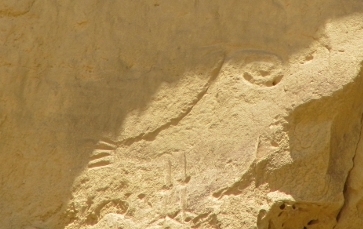In my last post, we rolled into Santa Fe, checked out the historic downtown and got dinner before settling down for the night. We got an amazing night’s sleep on our first night at the Hotel Chimayo, and headed out into a cold Santa Fe to find some breakfast and start the day’s sightseeing. We wandered around for a little while, checking out our options, before deciding on the Plaza Café. It was super-convenient, because as the name implies, it was right off the main square. It has been in business since 1905, and has been owned by the same family since 1947!
At the Plaza Café, Jon enjoyed the egg white omelet with a side of fruit, and I had the huevos rancheros (it seems to be a theme with us – he orders the more healthful meal, and I pig out. He eats more snacks – so it must even out!). The service was fast and friendly, and our server seemed to know many of the customers that came in. That says a lot about a restaurant.
We got on our way after breakfast, and our first stop was the Loretto Chapel. The Loretto Chapel was built by the Santa Fe Archdiocese as a convent chapel. Construction began in 1872. The architect died suddenly during construction, and it was discovered that due to the narrow design of the church, the choir loft could only be served by a ladder. The nuns weren’t comfortable with having to climb the ladder up to the choice loft in the long habits they wore, so they prayed for someone who could design and build a staircase that would fit into the space.
As the legend goes, on their ninth day of prayer a mysterious man showed up and announced that he was the man for the job, but that he needed total privacy during construction. He locked himself into the church and wouldn’t allow anyone to watch him work. Three months later, he finished the staircase, would not accept payment and disappeared as mysteriously as he had arrived. Further inspection showed that the staircase is made from non-native wood, and is completely free flying – it is not connected to any of the walls. The theory is that the staircase is narrow enough for the center pillar to provide enough support. The staircase is also made without nails; instead it is completely constructed with wooden dowels. It does two complete spiral rotations. The nuns believed that the staircase was a gift from God.
Although the Loretto Chapel was once a Catholic chapel, it has since been deconsecrated and sold to a private museum, which runs it as a tourist attraction and wedding chapel. The setting is a little cheesy, as there is an audio loop playing some corny religious music and a voice over explaining the story of the miraculous staircase. That said, admission was only $3 per person, and it was neat to see the staircase. When we were there, it was fairly quiet inside, so I could get some photos without people in them. However, shortly after we arrived, a large group of tourists arrived, so we made a hasty exit through the gigantic gift shop and back out to the street.
You should know that after construction, the staircase was attached to a support beam to help stabilize it, and the railings were added about 10 years after the original construction. So, it isn’t completely original. And in case you are absolutely enthralled with the story, there is a TV movie called The Staircase starring Barbara Hershey, that roughly depicts the story. I haven’t seen the movie, so if you have, be sure to let me know how it is, but don’t tell me how it ends… Ha!
After the Loretto Chapel, we made our way over to the “Oldest House in the United States.” The “house” is now a real estate office, but the sign outside indicates that it was built in approximately 1646. A quick search of the internet however, reveals that if this house was built in 1646, it is nowhere near the oldest house in the U.S. That distinction belongs to the cliff dwellings of the Puebloan people (now abandoned) or the homes of the Taos Pueblo (which are still occupied); they were built between 1,000 and 1,450 C.E. Or the several homes on the East Coast that are older.
This home makes the claim that it is the oldest because it was built on a pre-Spanish foundation thought to date to about 1,200 C.E. So, it is up to you to decide what really holds the title for “Oldest House in the United States.” You can go inside and see it, but we just took a look at the outside. We posed for photos (I even got Jon to pose!) and will just consider it to be the oldest house that we have ever seen in person. Until it’s not. Unless you are counting homes that are now ruins – then the ruins at Mesa Verde are the oldest homes we have seen in person. It’s all so complicated…
Have you ever been to Loretto Chapel or the “Oldest House in the U.S.”? What did you think?


























